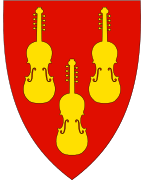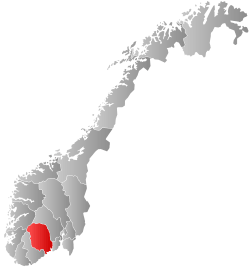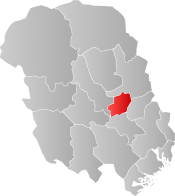Bø, Telemark
Bø is a village and municipality in Telemark county, Norway. It is part of the traditional region of Midt-Telemark, but was historically regarded as part of Grenland. The administrative centre of the municipality is the village of Bø i Telemark ("Bø in Telemark"). Bø has been a settlement since ancient times, a parish since the middle ages and became a municipality (formannskapsdistrikt) in 1838. The area of Lunde was separated from Bø in 1867 to become a separate municipality. Bø has a population of 5,977 (2015).
Bø kommune | |
|---|---|
 Coat of arms  Telemark within Norway | |
 Bø within Telemark | |
| Coordinates: 59°27′26″N 9°1′53″E | |
| Country | Norway |
| County | Telemark |
| District | Midt-Telemark |
| Administrative centre | Bø i Telemark |
| Government | |
| • Mayor (2011) | Olav Kasland (V) |
| Area | |
| • Total | 263 km2 (102 sq mi) |
| • Land | 258 km2 (100 sq mi) |
| Area rank | 292 in Norway |
| Population (1.1.2015) | |
| • Total | 5,977 |
| • Rank | 188 in Norway |
| • Density | 20/km2 (50/sq mi) |
| • Change (10 years) | 8.5% |
| Demonym(s) | Bøhering[1] |
| Time zone | UTC+01:00 (CET) |
| • Summer (DST) | UTC+02:00 (CEST) |
| ISO 3166 code | NO-0821 |
| Official language form | Nynorsk[2] |
| Website | www |
Bø's economy is mainly based on agriculture, forestry, tourism, education and public administration. Bø has the character of a university town and is home to one of the principal campuses of the University of Southeast Norway; it was also the seat of one of the university's three predecessor institutions, Telemark University College. Bø is well known for its cultural traditions within traditional music and artisanship, and its central position within Norwegian national romanticism with e.g. its Bunad traditions. Bø has several times been called "the most beautiful place on earth" in modern literature, e.g. in Bjørnstjerne Bjørnson's story En glad Gut (A Happy Boy).
General information
Name
The municipality (originally the parish) is named after the old Bø farm (Old Norse: Bœr), since the first church was built here. The name is identical with the word bœr which means "homestead" or "farm".[3]
Coat-of-arms
The coat-of-arms is from modern times. They were adopted on 19 February 1988. The arms show three gold-colored fiddles on a red background. Bø is historically known for its musical tradition, as well as the production of fiddles (similar to the hardingfele). The fiddle was thus chosen as an appropriate symbol for the municipality.[4][5]
Education
In 1923 the county of Telemark decided to start a secondary school in Bø, the equivalent of today's middle school or "ungdomsskole", called Telemark Realskole. At this time secondary schools mostly existed in the larger towns and cities, and most youngsters ended their schooling after 7 years. It was the county's intention to expand this school to a high school as soon as practically possible. This happened in 1947, and the school's name was Telemark Offentlige Landsgymnas. The existence of this school made it possible to establish Telemark College (Distriktshøgskulen i Telemark), which evolved into Telemark University College.
Attractions
Bø is famous for its waterpark Sommarland (the largest of its kind in Norway). Another tourist site in Bø is the Gygrestol rock formation. There is also Kroa i bø, one of the oldest music venues in Norway. The club won the award for "Concert promoter of the Year 2005" and is based on voluntary work from students of the Telemark University College.


Bø Old Church
Bo Church (Bø kyrkje) dates from ca. 1100. The church is in stone and has 200 seats. It was built in the Romanesque style, with long church plan and choir to the east. The sanctuary, choir loft and the apse are from the Middle Ages, whereas the narthex was built to the 1600s.[6]
Bø Church
Bø New Church (Bø kyrkje) dates from 1875. The church is wooden and has 450 seats. The church was built in Neo-Gothic style. There are wood carvings on the altarpiece, pulpit, lectern and west gallery.[7]
Notable residents
- Halvor Kleppen, TV personality and writer
- Neri Valen, member of Parliament
- Hallvard Eika, member of Parliament
- Olaf Rye, general
- Johan Henrik Rye, President of the Storting
- Hans Kleppen, ski jumper
- Geir Barvik, banker
- Lars Arvid Nilsen, shot putter
- Webjørn Espeland, radio personality
- Agnes Buen Garnås, traditional musician
- Øyvind Storesund, musician
- Vidar Våer, musician
- Varg Vikernes, musician
Sister cities
The following cities are twinned with Bø:[8]


Gallery
 Bø Station
Bø Station Mølleplassen
Mølleplassen Farm in Bø
Farm in Bø Farms in Bø
Farms in Bø Oterholtfossen
Oterholtfossen Lifjell
Lifjell- A typical farm house in Børte
References
- "Navn på steder og personer: Innbyggjarnamn" (in Norwegian). Språkrådet.
- "Forskrift om målvedtak i kommunar og fylkeskommunar" (in Norwegian). Lovdata.no.
- Rygh, Oluf (1914). Norske gaardnavne: Bratsbergs amt (Dokumentasjonsprosjektet) (in Norwegian) (7 ed.). Kristiania, Norge: W. C. Fabritius & sønners bogtrikkeri. p. 197.
- Norske Kommunevåpen (1990). "Nye kommunevåbener i Norden". Retrieved 2009-01-17.
- "Kommunevåpen og ordførarkjede" (in Norwegian). Bø kommune. Archived from the original on 2011-07-24. Retrieved 2009-01-17.
- "Bø gamle kyrkje, Bø i Telemark". Den norske kirke. Retrieved October 1, 2016.
- "Bø kyrkje, Bø i Telemark". Den norske kirke. Retrieved October 1, 2016.
- "Vennskapskommunar" (in Norwegian). Bø kommune. Archived from the original on 2011-07-24. Retrieved 2009-01-17.
External links


- Municipal fact sheet from Statistics Norway

- Bø Sommarland waterpark (in Norwegian)
- Kroa i Bø music venue

